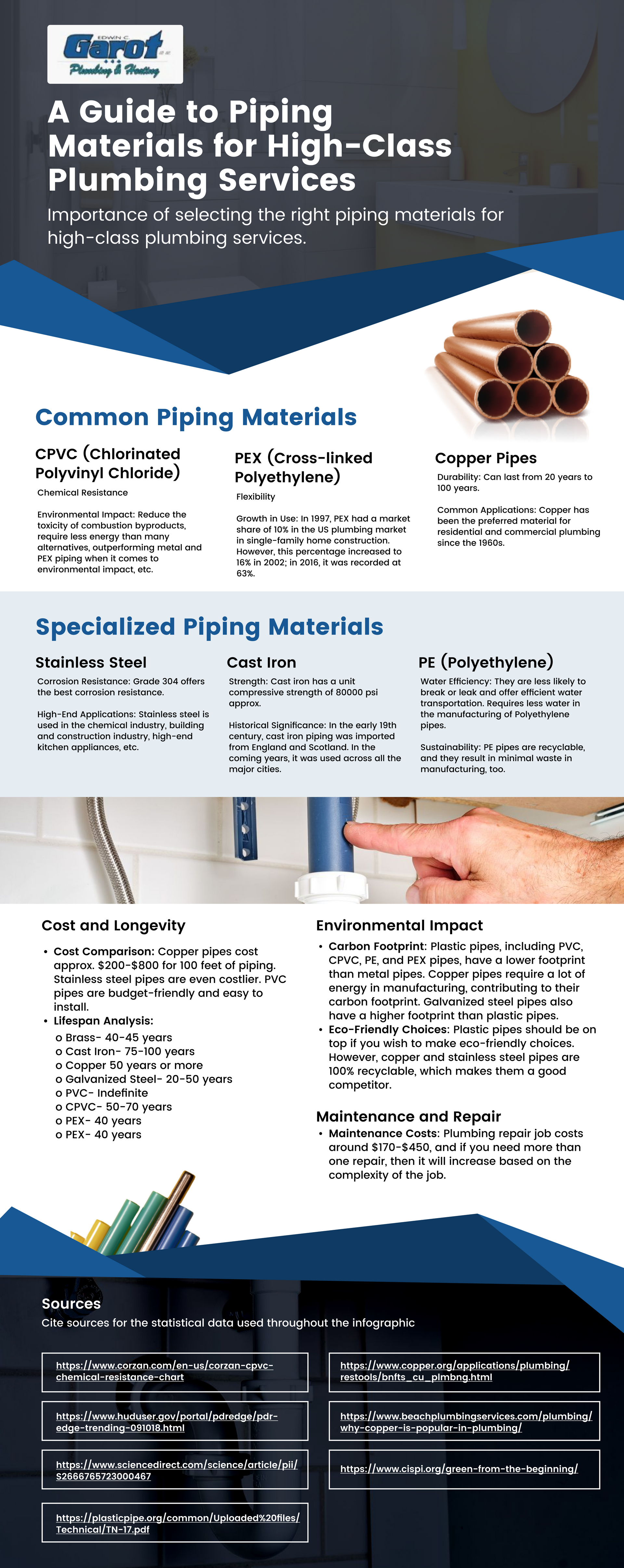A Guide to Piping Materials for High-Class Plumbing Services
JB Thompson
This is a subtitle for your new post

Importance of selecting the right piping materials for high-class plumbing services.
Common Piping Materials
1. Copper Pipes
- Durability: Copper pipes are a good choice for residential and commercial plumbing. Based on the copper type you choose and the surrounding climate, copper pipes can last from 20 years to 100 years. However, many factors affect the lifespan of copper pipes.
- Common Applications: Copper Development Association Inc. says almost 95 percent of US plumbing has copper pipes. And why not? Copper has been the preferred material for residential and commercial plumbing since the 1960s. In addition, these pipes are corrosion-resistant and are known for their durability.
2. PEX (Cross-linked Polyethylene)
- Flexibility: PEX pipes are used in residential plumbing due to their flexibility, durability, and corrosion resistance. Cross-linked polyethylene is used for numerous applications worldwide, but its ability to handle hot and cold water pressures has made it popular across the US.
- Growth in Use: PEX pipes have gained significant market share over the decade. In 1997, PEX had a market share of 10% in the US plumbing market in single-family home construction. However, this percentage increased to 16% in 2002; in 2016, it was recorded at 63%.
3. CPVC (Chlorinated Polyvinyl Chloride)
- Chemical Resistance: CPVC is popular in plumbing due to its chemical resistance against various organic compounds, salts, acids, and bases. It is also resistant to certain organic solvents such as alcohol, ketones, and esters. The material is flexible, durable, and corrosion-resistant, and thus, perfect for plumbing.
- Environmental Impact: When choosing plumbing material for your home, also consider the environmental impact of the material. CPVC pipes are superior to many other types as they reduce the toxicity of combustion byproducts, require less energy than many alternatives, outperforming metal and PEX piping when it comes to environmental impact, etc.
Specialized Piping Materials
1. Stainless Steel
- Corrosion Resistance: Stainless steel is known for its beautiful appearance and its corrosion resistance. Different stainless steel grades offer different levels of corrosion resistance. Grade 304 offers the best corrosion resistance. However, the surrounding conditions and its metallurgic composition matter a lot.
- High-End Applications: Stainless steel is a versatile metal and is used in multiple industries. It is used in the aviation industry due to its strength and ability to withstand temperatures. Rolex uses stainless steel in its timepiece production. Medical equipment production is incomplete without stainless steel. Apart from these, stainless steel is used in the chemical industry, building and construction industry, high-end kitchen appliances, etc.
2. Cast Iron
- Strength: Cast iron has a unit compressive strength of 80000 psi approx. It is a very strong material and, thus, very popular in plumbing. Different alloys change their properties, making them brittle and lending them the tensile strength it is known for.
- Historical Significance: Cast iron is a popular metal used in plumbing for centuries. In the early 19th century, cast iron piping was imported from England and Scotland. In the coming years, it was used across all the major cities.
3. PE (Polyethylene)
- Water Efficiency: Polyethylene pipes reduce water loss compared to other types of pipes. They are less likely to break or leak and offer efficient water transportation. In addition, it requires less water in the manufacturing of Polyethylene pipes.
- Sustainability: Consider the environmental impacts when installing plumbing systems in your home. PE pipes are recyclable, and they result in minimal waste in manufacturing, too.
Cost and Longevity
- Cost Comparison: Copper pipes are considered the gold standard in the plumbing industry but are very costly. They cost approx. $200-$800 for 100 feet of piping. Stainless steel pipes are even costlier, but they are known for their corrosion resistance and, thus, worth the cost. PVC pipes are thus more popular because they are budget-friendly and easy to install. Galvanized steel is also a cheaper option, but it rusts over time. In addition, a major consideration is the cost of labor involved.
- Lifespan Analysis: Plumbing systems have different lifespans based on the material used. To make an informed decision, check out the lifespans of various plumbing materials.
- Brass- 40-45 years
- Cast Iron- 75-100 years
- Copper 50 years or more
- Galvanized Steel- 20-50 years
- PVC- Indefinite
- CPVC- 50-70 years
- PEX- 40 years
- Steel- 80-100 years
Environmental Impact
- Carbon Footprint: The environmental impact of different piping materials is calculated considering the energy and resources spent on their manufacturing. The carbon footprint stands reduced if the materials can be recycled.
Plastic pipes, including PVC, CPVC, PE, and PEX pipes, have a lower footprint than metal pipes. Copper pipes require a lot of energy in manufacturing, contributing to their carbon footprint. Galvanized steel pipes also have a higher footprint than plastic pipes.
- Eco-Friendly Choices: Plastic pipes should be on top if you wish to make eco-friendly choices. However, copper and stainless steel pipes are 100% recyclable, which makes them a good competitor. In addition, also invest in touchless faucets, water-saving toilets, and low-flow fixtures.
Maintenance and Repair
- Leaks and Repairs: Several piping issues require you to choose the right plumbing material for your home. The most common pipe issues include frozen pipes, obstructed pipes, backed-up garbage, sewer backup, clogged drains, etc.
- Maintenance Costs: As per HomeAdvisor, an average plumbing repair job costs around $170-$450, and if you need more than one repair, then it will increase based on the complexity of the job. Investing in quality plumbing material is vital to ensure that you need minimum repair and maintenance over the coming years.
